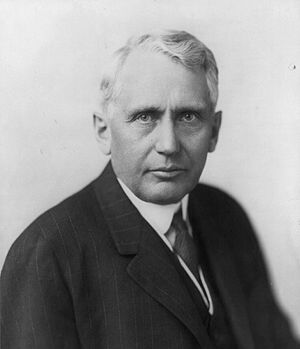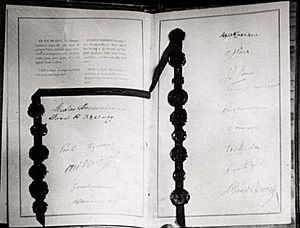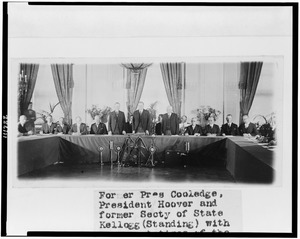Kellogg–Briand Pact facts for kids
| General Treaty for Renunciation of War as an Instrument of National Policy | |
|---|---|

Frank B. Kellogg, U.S. Secretary of State
|
|
| Signed | 27 August 1928 |
| Location | Quai d'Orsay, Paris, France |
| Effective | 24 July 1929 |
| Negotiators | |
The Kellogg-Briand Pact is an important international agreement. It's also called the Pact of Paris because it was signed in Paris, France. This happened on August 27, 1928. The main idea of the pact was to make countries agree not to use war to solve their problems. Even though it didn't stop all wars, it was a big step for international law. It helped shape how countries deal with each other today.
Contents
Why the Pact Was Proposed
The idea for this pact came from Aristide Briand in 1927. He was the foreign minister of France and had won a Nobel Peace Prize. Briand first suggested a treaty only between the United States and France. This treaty would make war between these two countries illegal.
Briand hoped this would make the relationship between France and the U.S. better. More importantly, he wanted to make sure the United States would help France if another war broke out in Europe.
Frank B. Kellogg, who was the U.S. Secretary of State, had a different idea. He suggested a bigger agreement that all nations could join. This agreement would be against war in general.
Signing the Agreement

After many talks, the pact was signed in Paris on August 27, 1928. Eleven countries signed it first:
- Australia
- Canada
- Czechoslovakia
- Germany
- India
- the Irish Free State
- Italy
- New Zealand
- South Africa
- the United Kingdom
- the United States
Later, four more countries added their support before the pact officially started. These were Poland, Belgium, France, and Japan. The pact officially began on July 24, 1929. In the end, 62 nations signed this important agreement.
In the United States, the Senate strongly approved the treaty. However, they added a special condition. This condition said that the treaty could not take away America's right to defend itself. It also meant the U.S. was not forced to take action against countries that broke the treaty.
Impact and Importance
The Kellogg-Briand Pact is still a valid agreement under international law today. In the United States, it is part of the country's highest laws, under the U.S. Constitution.
In practice, the pact did not stop future wars. For example, the Japanese invasion of Manchuria in 1931, the Italian invasion of Ethiopia, and the German invasion of Poland in 1939 all happened after the pact was signed. These events showed that the pact was not effective at preventing conflicts.
However, the pact is still very important. It helped create the idea that using military force is generally against international law. This was a big change in how countries thought about war.
Most notably, the pact was the legal basis for the idea of a "crime against peace". This means starting a war of aggression is a crime. People responsible for starting World War II were charged with this crime at the Nuremberg Trials.
Images for kids
-
French Foreign Minister Aristide Briand speaking
-
German Foreign Minister Gustav Stresemann signing
See also
 In Spanish: Pacto Briand-Kellogg para niños
In Spanish: Pacto Briand-Kellogg para niños






